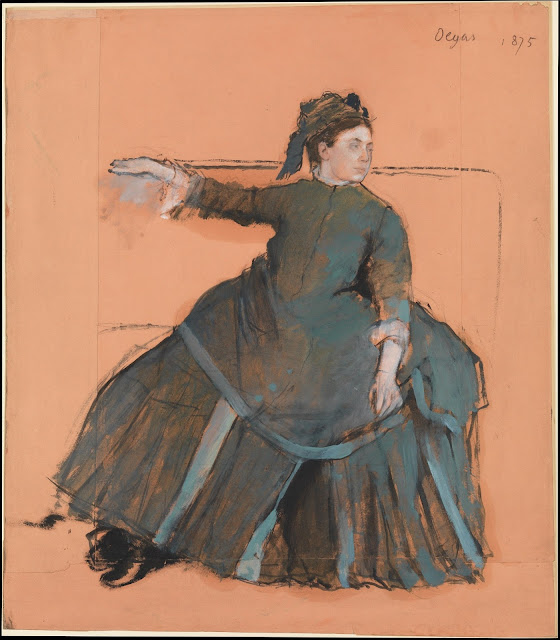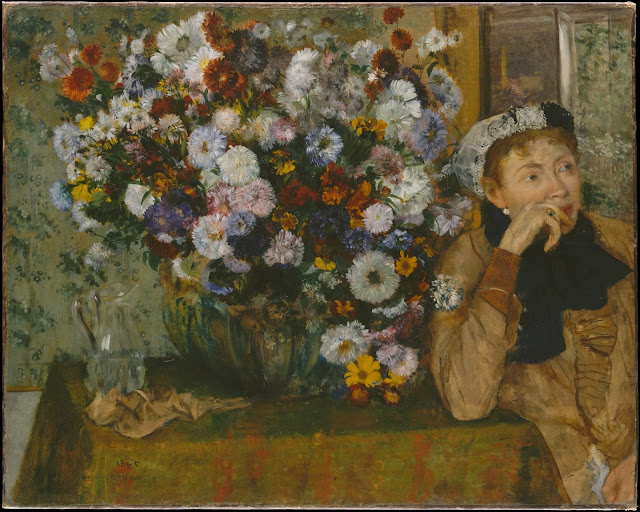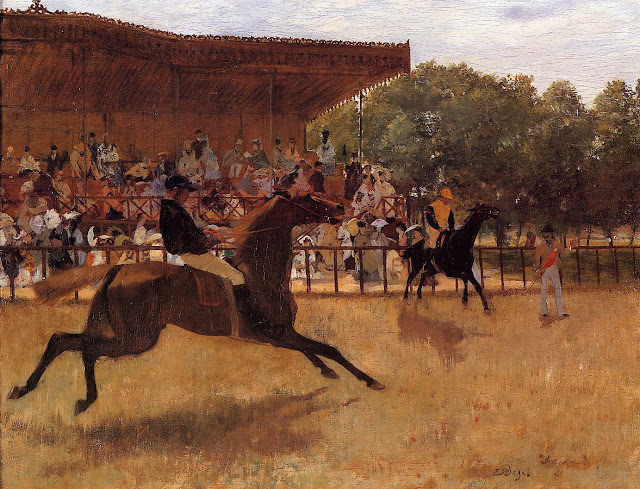 |
| Edgar Degas Ballet Rehearsal ca. 1875 gouache and pastel over monotype Nelson-Atkins Museum of Art, Kansas City formerly owned by Louisine Havemeyer |
"[Already in 1875] Mary Cassatt's enthusiasm for Degas's work knew no bounds. Before meeting the artist herself, she had already become his disciple, and remained so all her life. Her commitment to Degas was the most important and enduring element of her artistic career. It was only natural that Cassatt should make a convert of Louisine [then aged twenty and not yet married]. To share her excitement with her young friend, Cassatt took her to a colorshop (probably père Julien Tanguy's on the rue Clauzel), where she could see one of Degas's pastels; she now urged Louisine to buy Degas's Ballet Rehearsal. Louisine thought that she had developed a rather advanced taste in art under Mary Cassatt's tutelage, but she found this curious pastel (actually pastel and gouache over monotype), with its asymmetrical composition and abruptly chopped-off figures, difficult to comprehend. Her reaction to the picture is best described in her own words: "It was so new and strange to me! I scarcely knew how to appreciate it, or whether I liked it or not, for I believed it takes special brain cells to understand Degas. There was nothing the matter with Miss Cassatt's brain cells, however, and she left me in no doubt as to the desirability of the purchase and I bought it upon her advice." Thus in 1875 Louisine Elder became Degas's first American patron; the pastel had cost 500 francs, then worth about $100. At the age of twenty, Louisine acquired a taste for collecting that was to remain a lifelong pursuit. Without suspecting that it would grow to such proportions, Mary Cassatt had planted the seed, though before Louisine's marriage her purchases were limited by her small budget. To buy Degas's pastel, she had to ask her two sisters to loan her their monthly allowances which, added to her own, provided the necessary sum."
 |
| Edgar Degas The Collector of Prints 1866 oil on canvas Metropolitan Museum of Art, New York formerly owned by Louisine Havemeyer |
"It appears that the Havemeyers had made another trip to Europe in the spring of 1891. While there is no mention of it in Louisine's Memoirs, an entry in Durand-Ruel's Paris register refers to a Havemeyer purchase there in April of that year, the very month that Mary Cassatt had her first individual show at the Galerie Durand-Ruel. It must have been during this otherwise unrecorded trip that the Havemeyers paid a visit to Degas's studio in the company of Cassatt. On this occasion Louisine apparently selected, for the price of $1,000, a small oil painting, The Collector of Prints, a choice that seems to have taken into consideration Harry's taste for portraits of men. Degas asked to keep the work for a while, because he wished to "add a few touches." Yet a year later Mary Cassatt mentioned this painting in a letter to Louisine: "By the way, Degas thinks most seriously of finishing your picture for you. However, when we see his drawings and his fine pastels, we forgive him everything." Cassatt had been through this routine of Degas's before when she tried to get certain works away from him for her brother Alexander; but now Degas was particularly tenacious and, as time passed, even raised the price of the painting, a procedure Harry did not appreciate. As reported by Louisine: "It was of no use! Degas was quite stubborn about it, and the idea was so fixed in his mind that he was entitled to the increase in value that at last Mr. Havemeyer yielded. We felt that we were perhaps fortunate to get the picture back unspoiled, for Degas had a dangerous habit of retouching which sometimes spoiled a picture." Degas held on to his canvas for even longer than Louisine remembered: on October 24, 1894 Cassatt would write to either Joseph or George Durand-Ruel: "I saw Degas, as Durand-Ruel [senior] had requested me to do before his departure, and I did all that I could to persuade him to give up the picture for the Havemeyers. I thought that was absolutely determined, but it seems that he hasn't done it yet." Not until December 13, 1894 would the Durand-Ruels be able to send the Havemeyers their long-awaited The Collector of Prints. No wonder Degas acquired a reputation for eccentric behavior; even his admirers found it trying to do business with him."
 |
| Edgar Degas Dancers Practicing at the Barre 1877 mixed media on canvas Metropolitan Museum of Art, New York formerly owned by Louisine Havemeyer |
"December 1912 brought Louisine an opportunity to acquire some exceptional pictures in the estate sale in Paris of the painter and engineer Henri Rouart, an old friend of Degas who had assembled a famous collection of nineteenth-century French works. . . . As the date for the Rouart auction drew closer, Louisine emphasized to Joseph Durand-Ruel, then in New York, how imperative it was that his firm keep absolutely confidential any purchases she might make. Being assured that it was a house rule never to divulge such information, Louisine submitted her list of bids; in each instance she went substantially higher than the estimates. . . . On December 10, 1912 Paul Durand-Ruel purchased on behalf of an unknown buyer Degas's Dancers Practicing at the Barre for the record price of $95,700, the highest amount ever paid for the work of a living artist. Rumors as to the mysterious purchaser's identity appeared in the press on both sides of the Atlantic, but Durand-Ruel would only say that he had received an unlimited order from America to outbid any competitors. . . . The aged Degas, when asked how it felt to have his picture knocked down at such an astronomical price, simply replied that he felt like the horse that has won the Grand Prix and gets nothing for it but his oats. On December 13, Horace Havemeyer sent a draft for 478,500 francs ($95,700) to the Galerie Durand-Ruel for his mother's account. . . . Meanwhile, Mary Cassatt and the rest of the international art world were trying to guess the new owner of Degas's Dancers Practicing at the Barre. Louisine soon wrote to Cassatt, letting her in on the secret, and on Christmas Day, 1912, the latter replied: "I have yours with the news, there is no danger of my speaking of it for I have contradicted it several times. Well, you did right I think. . . ." The next day Cassatt wrote to Paul Durand-Ruel, stating what she thought was the reason behind Louisine's astonishing acquisition: "It was a matter of sentiment, since her husband had wanted it." In any case, Louisine had asserted herself, making the most staggering purchase of her life without anyone's advice. Degas's Dancers Practicing at the Barre was and remained the costliest painting in the Havemeyer collection . . ."
 |
| Edgar Degas Madame Théodore Gobillard (Yves Morisot) 1869 oil on canvas Metropolitan Museum of Art, New York formerly owned by Louisine Havemeyer |
 |
| Edgar Degas The Dancing Class ca. 1870 oil on canvas Metropolitan Museum of Art, New York formerly owned by Louisine Havemeyer |
 |
| Edgar Degas Seated Woman on Sofa 1875 oil on paper Metropolitan Museum of Art, New York formerly owned by Louisine Havemeyer |
". . . Louisine owed her new acquisition of three outstanding works by Degas to Mary Cassatt's initiative. No longer able to paint, Cassatt relished more than ever the pursuit of pictures, an occupation that took her mind off the horrors of war and her many problems. In 1915 an artist-dealer and friend of Degas's, Michel Manzi, had died, leaving a wife and daughters, whom he had told to apply first to Mary Cassatt, should they need to sell any pictures. When the Manzi heirs subsequently approached her, she excitedly wrote to Louisine: "I advise you to buy one of the finest Degas. It is much in the style of a Vermeer and quite as interesting, very quiet and reposeful. It is a beautiful picture. A woman in black seated upon a sofa against the light, the model was a sister of Berthe Morisot, not handsome, but a Degas! The picture has never been shown. . . . Then there is another thing I am to see, another picture, small, danseuses, very fine in execution." About The Dancing Class Cassatt told Louisine that Degas had refused to look at it even years ago, saying it reminded him of the days when he was young and had his eyes. Cassatt considered these works to be of exceptional quality and urged Louisine to purchase them, in spite of the high price the Manzi family wanted for them. She soon met with the heirs and convinced them to come down slightly in price as well as to "add to the bargain" an oil sketch on pink paper. Louisine could not refuse, when Cassatt insisted: "I am doing this for you, dear! I really think it is a chance and your collection of Degas ought to be very complete with these two pictures and the pastel [i.e., oil sketch]; it, too, is a fine thing." The transaction was completed within a month or two and the pictures were shipped before the United States entered the war in April 1917. Louisine was enchanted with both paintings: "It seems to me it is not a picture, it is not a portrait, it is an inspiration. Degas never did anything like it again. I doubt if he ever could, I doubt if ever any painter could do such a picture. It is forever! it is an art epoch in itself."
 |
| Edgar Degas Girl putting on her stockings ca. 1876-77 monotype Metropolitan Museum of Art, New York formerly owned by Louisine Havemeyer |
 |
| Edgar Degas Three Dancers Preparing ca. 1878 pastel Metropolitan Museum of Art, New York formerly owned by Louisine Havemeyer |
 |
| Edgar Degas Dancers, Pink and Green ca. 1890 oil on canvas Metropolitan Museum of Art, New York formerly owned by Louisine Havemeyer |
 |
| Edgar Degas Rehearsal in the Studio ca. 1874 oil on canvas Shelburne Museum, Vermont formerly owned by Louisine Havemeyer |
 |
| Edgar Degas Woman with Chrysanthemums 1865 oil on canvas Metropolitan Museum of Art, New York formerly owned by Louisine Havemeyer |
 |
| Edgar Degas Mlle Marie Dihau 1867-68 oil on canvas Metropolitan Museum of Art, New York formerly owned by Louisine Havemeyer |
 |
| Edgar Degas Woman Ironing 1873 oil on canvas Metropolitan Museum of Art, New York formerly owned by Louisine Havemeyer |
 |
| Edgar Degas The False Start 1864 oil on canvas Yale University Art Gallery formerly owned by Louisine Havemeyer |
– quoted passages from The Havemeyers: Impressionism Comes to America by Frances Weitzenhoffer (New York: Abrams, 1986)